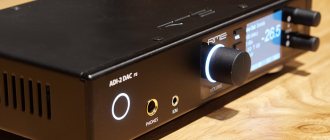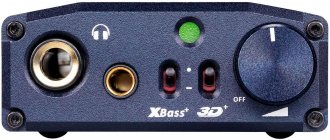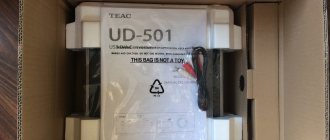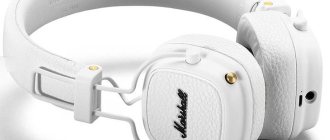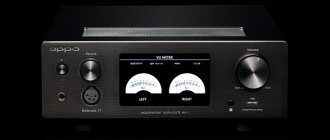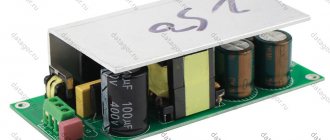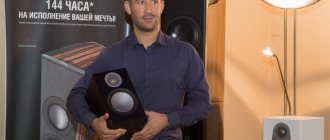A price tag of $1,000 for a stationary digital-to-analog converter with a headphone amplifier function is no longer the “top”, and many manufacturers mock fans of high-quality sound by charging prices exceeding several thousand. All the more valuable in our time are products that can provide good quality at an affordable price. The Audio-Gd company is one of the manufacturers of just such devices, and their NFB-11 “combine” has recently been quite updated, and today I will tell you about it.
I am always interested in such budget models, since they allow us to “close the question” of the source of music for those who have not fallen into complete audiophilia and are not ready to spend tons of money. This is especially interesting in the case of budget models from companies that also offer top-end solutions, since many of the “tricks” of older models in this case will inevitably be transferred to the younger ones (as, for example, some Formula 1 ideas are introduced over time into the mass auto industry).
In the case of the NFB-11, this feature was the proprietary amplifier circuit from Audio Gd. This combine uses the older DAC from ESS Technologies, Saber 9018. It can usually be found in much more expensive models (you can buy the Audio Gd NFB-11 for only $320). To improve performance, the chip is configured to operate with a current output (the voltage output is 12 dB worse in terms of signal-to-noise ratio). Typically, in this mode of connecting a DAC in the amplifier, 3 more op-amp chips are required. Audio-Gd used its own open-loop amplifier circuit using discrete components. This made it possible to greatly shorten the signal path, and, according to the developers, to provide the most uncolored sound of the Saber 9018.
Also, special attention was paid to the power supply; about half the space inside the device is allocated for a transformer and the necessary wiring to ensure stable power supply without interference. In the 2015 version, the transformer power was increased from 20 to 35 watts.
For those who want to achieve better sound quality, there is the option of installing improved clock generators for the DAC and USB chip.
Specifications
- Signal to noise ratio: 118 dB
- Level (headphone output): 10 VRMS
- Level (Adjustable Line Out): 5 VRMS
- Level (unregulated line output): 2.5 VRMS
- Power: 3500 mW @ 25Ω, 1800 mW @ 50Ω, 150 mW @ 600Ω
- Output impedance: 2Ω
- Maximum sampling rate: 384KHz USB, 192KHz Coax, 96KHz optical
- Frequency range: 20 Hz – 20 KHz (-0.2 dB)
- Power consumption: 12 W
- Dimensions (with legs): 180 mm × 220 mm × 55 mm
- Net weight: 2kg
DAC + Headphone Amplifier + Preamplifier Audio-gd NFB-11.38 Perfomance Edition
- Free shipping
- Hi-Audio.ru is the official distributor of Audio-gd. Manufacturer's warranty
- +3 months additional warranty
- Only we have a $10 discount on the purchase of the top Jriver music player (worth $50)!
- 3% discount on your next order!
The maximum version with femto generators Accusilicon 318B
Audio-gd NFB-11.38 is sold - this is a DAC, headphone amplifier and preamplifier using discrete components. The output amplifier stage is implemented without feedback using proprietary current transfer technology (ACSS). The device uses only high-quality audio components: ALPS 27 potentiometer, Toshiba transistors, pure copper RCA connectors (CMC).
The new version of the DAC 11.38, released in 2022, includes several important improvements:
1. Use ES9038 digital-to-analog converter instead of ES9018. 2. The USB receiver is now Amanero combo 384 instead of USB32, which was used previously. Considering that the Amanero interface is one of the best today (and according to the manufacturer Audio-gd, the best) and the board itself costs about $97 (not including shipping), this improvement is very significant. 3. The power supply circuit of the device has also been improved. Dual PSUs are used with very high speed and minimal noise. This solution improves the consistency of power supply. As a result, the new device sounds cleaner and the background is even blacker. In terms of power supply, 8 groups of regulators are used! This solution is more likely to be found in devices costing $1,500 or more. The power supply for the left and right channels is separate. 4. Switching between DSD and PCM files is now carried out using the MCU. As a result, an unnecessary button has been removed from the rear panel, and switching between files in different formats is not accompanied by loud clicks, as before. 5. Jumpers have been added inside the device to select the desired digital filter setting, which will allow you to slightly change the sound of the device to suit the listener’s taste. 6. Jumpers have also been added inside the device to adjust the analog filter settings. You can choose between a neutral and warmer sound.
The Performance Edition was created with the goal of obtaining the highest possible technical performance. This device has a very low THD+N and a flat frequency response. Moreover, all this is achieved with a complete rejection of feedback! The sound of the device is smooth, transparent, but at the same time musical.
The DAC has several input signal channels: coaxial, optical and USB.
Audio-gd NFB-11.38 can work as a pure DAC (in this case, volume control and internal amplifier are disabled) or as a preamplifier (volume is adjusted with a knob on the front panel).
The device uses the Saber ES9038 Pro chip from ESS Technology, which is capable of working with files up to 32 bit/384 kHz (PCM), DXD and DSD.
Audio-gd NFB-11.38 is based on the use of proprietary technology called ACSS. The current signal from the ES9038 chip is fed to one ACSS amplifier. And this amplifier has only one current amplifier stage. Thus, the operation circuit of Audio-gd NFB-11.38 becomes simpler, and the signal path becomes shorter. In addition, the ES9038 chip itself works better in current mode (since otherwise its THD+N indicator is 12 dB worse). A short signal path results in a more detailed and dynamic sound and an almost complete absence of coloration in the sound.
Audio-gd NFB-11.38 can only be purchased in black.
Specifications
Inputs:
Coaxial: up to 24 bit / 192 kHz
Optical: up to 24 bit / 96 kHz
USB: up to 32 bit/ 384 kHz (PCM), DXD, DSD64-512
Operating systems: Windows, Mac OS X, Linux
Outputs:
Output level (RCA): 2.5 Vrms (fixed output), 5 V max (adjustable output)
Frequency response: 20 Hz - 20 kHz (-0.2 dB), 3 Hz - 350 kHz (analog part)
THD+N: 0.00123%
SNR: 120 dB
Output Impedance: 1 ohm (headphones), 2 ohms (line outputs)
Headphone Amplifier:
Output power: 150 mW/600 Ohm, 300 mW/300 Ohm, 900 mW/100 Ohm, 1.8 W/50 Ohm, 3.5 W/25 Ohm
Output Level: 10 Vrms
Power: AC 220-240 V 50/60 Hz
Power consumption: 13 W
Weight: 2.2 kg
Size: 220*180*55 mm
Contents: network cable, USB cable
Packaging and delivery
The NFB-11 box is traditionally simple, ordinary brown cardboard with foam inserts inside that reliably protect the device. In the kit, in addition to the combine itself, you will receive a power cord, a USB cable (the most common one) and a pair of spare self-adhesive legs, in case the ones already glued on come off.
They also put a small set of parts in the box, as I understand it, in case of possible repairs (the first time I’ve seen such forethought).
Design and management
For its price, this combine is made very well. The body, albeit made of thin metal, has ventilation holes at the top and bottom. Its dimensions are quite compact, so it can easily fit on your desktop. The device itself is surprisingly light, so you need to ensure it has reliable contact with the table, so the silicone legs will secure it from unwanted movements.
All controls are traditionally located on the rear and front panels.
At the rear there are inputs: a power connector combined with a switch, a USB input, coaxial and optical S/PDIF, as well as a pair of RCA line-out connectors. If desired, the RCA connector of the coaxial input can be replaced with a BNC (made by the manufacturer).
The front panel houses the headphone output and all controls. The first three-position switch allows you to choose where to output the sound: headphone output, line output with or without volume control. The next switch is used to select the gain: high or low. Nearby is a silver volume control knob; a good ALPS variable resistor is used, so there is practically no noise during adjustment and channel imbalance. Last on the right is a three-position input selector switch: USB, optical or coke.
In principle, the appearance is quite ascetic, but everything is put together well, there are no noticeable flaws.
For some reason, this Audio-Gd amplifier has a hardware switch that turns off the headphones as soon as the audio signal stops coming to the input. This is not a problem, but the quiet periodic clicking of the relay can be a little annoying.
AUDIO-GD NFB-11.38 Performance Edition
The Audio GD NFB 11.38 Performance Edition is a high-end, compact DAC + headphone amplifier and open-loop discrete preamplifier. Works great as an external sound card.
The latest exclusive model for 2022 in the top-end “full upgraded” configuration on premium clock generators Accusilicon 318B (femtosecond Accusilicon 318 B clock) to minimize jitter. The device has received a number of significant improvements and improvements compared to the previous standard model AUDIO-GD NFB 11.38, which significantly affected the overall sound quality, which is unique for this price category.
1. The ES9038 PRO digital-to-analog converter from ESS Technology is used, which is capable of working with files up to 32 bit/384 kHz (PCM), DXD and DSD up to 512 inclusive.
2. The Amanero Combo 384 interface, which is one of the best today, is installed as a USB receiver.
3. The power system has been improved, which now consists of 8 PSU groups. This solution improves the consistency of power supply. As a result, the new device sounds much cleaner due to the minimization of jitter.
3.1 The digital circuits are equipped with 4 groups of ultra-high-speed PSU regulators with minimal noise.
3.2 In analog circuits, 2 groups of super linear discrete power regulators are used.
3.3 2 more PSU groups are power regulators for discrete transistors. The output ripple is significantly lower than 1 µV. Each of the two groups serves to separate the left and right channels of the ES9038 PRO, significantly improving sound quality in terms of detail and dynamics. Separate power supplies for the left and right channels create a much wider and deeper soundstage.
4. Ultra-low THD for this price category.
5. Switching between DSD and PCM files is carried out using the MCU.
6. Switchable digital filters, which allows you to adapt the sound of the device depending on the listener’s preferences.
7. Analog filter adjustments. You can choose between a neutral and warmer sound.
8. The output amplifier stage is implemented without feedback using proprietary current transfer technology (ACSS).
9. Only high quality audio components are used: ALPS 27 potentiometer, Toshiba transistors, pure copper RCA connectors (CMC).
10. Four high-speed output transistors of 20W each (80W in total) are used, allowing you to drive any headphones with low sensitivity. 11. Premium Accusilicon 318B clock generators with low phase noise are installed.
12. The DAC has several input signal channels: coaxial, optical and USB.
Audio-GD NFB 11.28 PE is capable of operating as a pure DAC (in this case, volume control and internal amplifier are turned off with a button on the front panel) or as a preamplifier (volume is adjusted with a knob on the front panel), as well as in headphone amplifier mode with two gain levels , providing support for headphones with sensitivity below 95dB.
Specifications
Inputs:
Coaxial: up to 24 bit / 192 kHz
Optical: up to 24 bit / 96 kHz
USB: up to 32 bit/ 384 kHz (PCM), DXD, DSD64-256
Operating systems: Windows, Mac OS X, Linux
Outputs:
Output level (RCA): 2.5 Vrms (fixed output), 5 V max (adjustable output)
Frequency response: 20 Hz - 20 kHz (-0.2 dB), 3 Hz - 350 kHz (analog part)
THD+N: 0.00123%
SNR: 120 dB
Output Impedance: 1 ohm (headphones), 2 ohms (line outputs)
Headphone Amplifier:
Output power: 150 mW/600 Ohm, 300 mW/300 Ohm, 900 mW/100 Ohm, 1.8 W/50 Ohm, 3.5 W/25 Ohm
Output Level: 10 Vrms
Power: AC 220-240 V 50/60 Hz
Power consumption: 13 W
Weight: 2.2 kg
Size: 220*180*55 mm
Sound
The following equipment was used to listen to the amplifier:
- MacBook Pro Retina Late 2013 as a source
- Fidelia as a player
- Headphones Philips Fidelio X1, AKG K702, ZMF Fostex, Fischer Audio FA-003 Bog Oak Limited Edition, Fischer Audio FA-011 Limited Edition Japan, Sennheiser HD800
- Recordings in lossless format
I don’t know how close to the truth the developers’ statements about “the most accurate representation of the character of the Saber 9018” are, but the sound of this combine is really similar to what one usually expects to hear from this chip. It is almost neutral, with a slight bias towards a light sound, the presentation is spacious, highly detailed and excellent speed. The noise level is quite low, unless you take the most sensitive headphones, it is practically inaudible.
The bass is collected and neat. Quantitatively, there is a lot of it, but it is slightly insufficient to correct the character of light-colored headphones and to satisfy those who like an excess of low frequencies. There is excellent speed, texture transmission, everything that a good bass needs. The NFB-11 unravels and delivers complex instrumental parts of low-frequency instruments with good control and authority. Ondeokza drums sound very tight and vital.
Mid frequencies are the clear strength of this device. Thanks to the excellent resolution and speed characteristics, all the nuances of the voice and most instruments are perfectly conveyed. All sound sources are well positioned and separated from each other, this helps create a three-dimensional imaginary scene. Knopfler's vocals are conveyed with all the subtlest nuances, and the piano recordings make you believe that the listener is really in the concert hall.
The treble is also well detailed, light and extended, although there is a little more than necessary (at least for my taste). This problem can be solved by choosing the right headphones; just choose a model with a darker pitch. The most complex combination of special effects of Mars Volta is fascinating and completely immerses you in the music.
Audio-gd NFB-11.38
The new version of the Audio-gd NFB-11.38 , released in 2022, includes several important improvements:
1. Use ES9038 digital-to-analog converter instead of ES9018. 2. The USB receiver is now Amanero combo 384 instead of USB32, which was used previously. Considering that the Amanero interface is one of the best today (and according to the manufacturer Audio-gd, the best) and the board itself costs about $97 (not including shipping), this improvement is very significant. 3. The power supply circuit of the device has also been improved. Dual PSUs are used with very high speed and minimal noise. This solution improves the consistency of power supply. As a result, the new device sounds cleaner and the background is even blacker. 4. Switching between DSD and PCM files is now carried out using the MCU. As a result, an unnecessary button has been removed from the rear panel, and switching between files in different formats is not accompanied by loud clicks, as before. 5. Jumpers have been added inside the device to select the desired digital filter setting, which will allow you to slightly change the sound of the device to suit the listener’s taste. 6. Jumpers have also been added inside the device to adjust the analog filter settings. You can choose between a neutral and warmer sound. 7. TCXO clock generators are used instead of simpler versions.
The DAC has several input signal channels: coaxial, optical and USB.
Audio-gd NFB-11.38 can work as a pure DAC (in this case, volume control and internal amplifier are disabled) or as a preamplifier (volume is adjusted with a knob on the front panel).
The device uses the Saber ES9038 Pro chip from ESS Technology, which is capable of working with files up to 32 bit/384 kHz (PCM), DXD and DSD.
Audio-gd NFB-11.38 is based on the use of proprietary technology called ACSS. The current signal from the ES9038 chip is fed to one ACSS amplifier. And this amplifier has only one current amplifier stage. Thus, the operation circuit of Audio-gd NFB-11.38 becomes simpler, and the signal path becomes shorter. In addition, the ES9038 chip itself works better in current mode (since otherwise its THD+N indicator is 12 dB worse). A short signal path results in a more detailed and dynamic sound and an almost complete absence of coloration in the sound.
Compatibility
Based on the sound signature, this device is better suited for dark and neutral headphones. Light models may turn out to be too bright (although this is not an acquired taste). The NFB-11 performed well with Philips and ZMF, and the phishers also showed up nicely. The AKG K702, despite very good opening, sounded a little thin. 800 Sennheiser is clearly contraindicated for this device.
The combine is quite critical of recordings; poor mixing and mastering flaws are very noticeable with it. Listening to MP3 at low bitrates is completely impossible. Genre-wise, I would recommend it primarily for lovers of instrumental music, vocals, live recordings, where resolution, volume and mid frequencies are important.
Several examples of tracks that are well suited to this combine.
Massive Attack - Teardrop. Records from these trip-hop monsters are always good material for testing. Their tracks have everything from deep bass to quiet percussion. The NFB-11 resolution helps it handle the famous series' opening theme.
Tuomas Holopainen - A Lifetime of Adventure. The solo project of the “megamind” Nightwish clearly showed who the main composing talent in the group is. A light symphonic poem, permeated with complex vocals, is also fully revealed by the DAC.
Pink Floyd - Sum. The background, almost ambient intro smoothly transitions into a typically “Floyd” track, making one remember the band’s best work, and thanks to the NFB-11, Gilmour’s guitar is recognizable from the very first chords.
